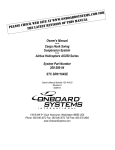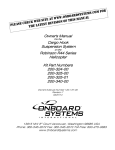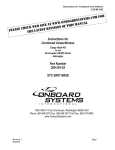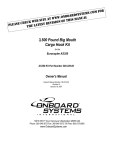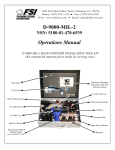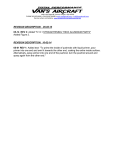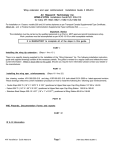Download 120-106-01 - Onboard Systems International
Transcript
Owner's Manual Talon LC Hydraulic Cargo Hook Kit on the Airbus Helicopters AS350 Part Number 200-281-01, 200-281-02 Owner's Manual Number 120-106-01 Revision 7 05/14/14 13915 NW 3rd Court, Vancouver, WA 98685 USA Phone: 360-546-3072 Fax: 360-546-3073 Toll Free: 800-275-0883 www.OnboardSystems.com This page intentionally left blank. RECORD OF REVISIONS Revision Date Page(s) Reason for Revision 0 06/16/06 All Original issue. 1 01/14/08 2-10, 2-11 Added “Remove rubber bumpers from swing assembly” instruction and updated Figure 2.2.4. Removed color labels from wiring diagram Figure 2.2.3. 2 02/10/09 5-3 & 5-6 3 09/29/09 2-3, 2-7, 3-1 4 08/03/10 Section 1 through 4 Corrected P/N 232-240-00 to 232-241-00 on 232-22200 illustrated parts list. Updated illustrated parts list to show P/N 232-240-01 used on P/N 232-241-00. Updated Figure 2.1.3 to show complete collective, added note on page 2-7 to allow alternative routing, clarified Figure 3.1. Replaced P/N 212-014-00 with 212-014-01 and updated hydraulic fluid filling instructions to use new kit. Updated warnings, cautions and notes section to safety label section. Updated safety label format throughout document. 5 12/19/11 5-7 Replaced Cup Seal (P/N 556-038-00) with Quad Ring (P/N 556-097-00) inside Slave Cylinder Assembly. 6 10/11/13 5-6 Replaced Slave Cylinder Plumbing P/N 232-240-01 with P/N 232-240-02. 7 05/14/14 2-2, 3-2, 3-3 Updated cargo hook rigging section, changed recommended minimum bend radii of hose to 1.5 inches. Register Your Products for Automatic Notifications Onboard Systems offers a free notification service via fax or email for product alerts and documentation updates. By registering your Onboard Systems products at our website, we will be able to contact you if a service bulletin is issued, or if the documentation is updated. You can choose to receive notices on an immediate, weekly, or monthly schedule via fax, email or both methods. There is no charge for this service. Please visit our website at www.onboardsystems.com/notify.php to get started. ii This page intentionally left blank. CONTENTS Section 1 General Information Introduction, 1-1 Safety Labels, 1-1 Specifications, 1-2 Inspection, 1-2 Bill of Materials, 1-3 Theory of Operation, 1-4 Section 2 Installation Instructions 2.1 2.2 2.3 2.4 2.5 2.6 2.7 Hydraulic Release System Installation, 2-1 Cargo Hook Installation, 2-9 Installation Check-Out, 2-12 Component Weights, 2-13 Cargo Hook Location, 2-13 Paper Work, 2-13 Filling Hydraulic Release System, 2-14 Section 3 Operation Instructions Operating Procedures, 3-1 Cargo Hook Rigging, 3-2 Cargo Hook Loading, 3-4 Section 4 Maintenance Instructions for Returning a System to the Factory, 4-1 Section 5 System Part Numbers 200-281-01 AS 350 Hook Replacement Kit, 5-1 232-222-00 Cargo Hook Link Assembly, 5-2 232-146-00 Link Assembly, 5-3 232-166-00 Master Cylinder Assembly, 5-4 232-241-00 Slave Cylinder Assembly w/ Plumbing, 5-5 232-169-00 Slave Cylinder Assembly, 5-6 Section 6 Certification STC, 6-1 Canadian Approval, 6-3 iii This page intentionally left blank. Section 1 General Information Introduction The 200-281-01 and 200-281-02 Cargo Hook Kits are approved as a replacement for the following cargo hook on Airbus Helicopters AS350 Series, equipped with a B3 type swing system. The B3 type swing systems are installed on AS350B3 models and can be retrofitted to earlier models via Airbus Helicopters Service Bulletin 2500.62. P/N AS 21-5-7 Manufacturer Siren The 200-281-02 Cargo Hook Kit is approved for installation on the AS350B3 model. The 200-281-01 is approved for installation on the AS350B2 and earlier models. Safety Labels The following definitions apply to Safety Labels used in this manual. Indicates a hazardous situation which, if not avoided, will result in death or serious injury. Indicates a hazardous situation which, if not avoided, could result in death or serious injury. Indicates a hazardous situation which, if not avoided, could result in minor or moderate injury. Draws the reader’s attention to important or unusual information not directly related to safety. Used to address practices not related to personal injury. General Information 1-1 Specifications Table 1-1 P/N 528-028-00 Cargo Hook Specifications Design load Design ultimate strength Electrical release capacity Mechanical release capacity Force required for mechanical release at 3,500 lb. Electrical requirements Minimum release load Unit weight Mating electrical connector 3,500 lbs. (1,580 kg.) 13,125 lbs. (5,952 kg.) 8,750 lbs. (3,970 kg.) 8,750 lbs. (3,970 kg.) 12 lbs max. @ Master Cylinder 22-32 VDC 6.9 – 10 amps 0 pounds 3.0 pounds (1.35 kg.) PC06P8-2S Load capacities given are for the equipment described only. Loading limits for your particular helicopter model still apply. Consult your flight manual. Inspection Inspect the cargo hook for evidence of damage, corrosion and security of lock wire and fasteners. If damage is evident, do not use the unit until it has been repaired. 1-2 General Information Bill of Materials The following items are included with the Cargo Hook Kit, if shortages are found contact the company from whom the system was purchased. Table 1-2 Bill of Materials General Information Part Number Description 120-106-01 121-014-01 122-015-00 123-013-01 215-169-00 232-222-00 232-165-00 232-165-01 235-135-00 291-105-00 510-453-00 510-042-00 510-102-00 512-005-00 500-065-00 505-014-00 590-013-00 450-001-00 450-120-00 450-113-00 510-486-00 Cargo Hook Kit Owner’s Manual Flight Manual Supplement Cargo Hook Service Manual ICA Maintenance Manual AS350 Light Indicator Placard Cargo Hook/Link Assembly Master Cylinder Assembly Master Cylinder Assembly Disconnect Bracket Friction Handle Bolt Washer Nut Adel Clamp Grommet Edging Grommet Spiral Wrap 1/8” Heat Shrink Tubing, 1/2” Lg. ¼” dia. Heat Shrink Tubing, 4” Lg. ½” dia. Heat Shrink Tubing, 3” Lg. CherryMax Rivet Quantity 200-281-01 Quantity 200-281-02 1 1 1 1 2 1 1 1 1 1 1 1 1 1 48” 2 1 1 3 1 1 1 1 2 1 1 1 1 1 1 1 1 1 1 48” 2 1 1 3 1-3 Theory of Operation The primary elements of the Cargo Hook are the load beam, the internal mechanism, and a DC solenoid. The load beam supports the load and is latched through the internal mechanism. The DC solenoid and an external manual release cable provide the means for unlatching the load beam. A load is attached to the load beam by passing the cargo sling ring into the throat of the load beam and pushing the ring against the upper portion of the load beam throat, which will initiate the hook to close. In the closed position, a latch engages the load beam and latches it in this position. To release the load, the latch is disengaged from the load beam. With the latch disengaged, the weight of the load causes the load beam to swing to its open position, and the cargo sling slides off the load beam. The load beam then remains in the open position awaiting the next load. A load release can be initiated by three different methods. Normal release is achieved by pilot actuation of the push-button switch in the cockpit. When the push-button switch is pressed, it energizes the DC solenoid in the Cargo Hook, and the solenoid opens the latch in the internal mechanism. In an emergency, release can be achieved by operating the hydraulic release system. The hydraulic release system is operated via a lever in the cockpit and actuates the internal mechanism of the Cargo Hook to unlatch the load beam. The load can also be released by the actuation of a lever located on the side of the Cargo Hook. 1-4 General Information Section 2 Installation Instructions These procedures are provided for the benefit of experienced aircraft maintenance facilities capable of carrying out the procedures. They must not be attempted by those lacking the necessary expertise. 2.1 Hydraulic Release System Installation Remove the swing suspension, external electrical release harness and the external section of the manual release cable from the helicopter. Remove the lower cowlings as necessary to access and remove the internal section of the manual release cable system. The hydraulic release system installation consists of a fixed section and a removable section. The fixed section is routed from the release lever at the collective, underneath the cabin floor, and aft to meet up with the existing cargo hook electrical release harness (as shown in Figure 2.1.1). Figure 2.1.1 is an overview of the hose routing and the figures following detail the support installations at various points. Figure 2.1.1 Fixed Hydraulic Release System Installation Overview X 1790.15 X 2700 Centerline of fwd fuel tank support Y 400 A/C Centerline Connector Bracket FWD Y 400 View Looking Down See Figure 2.1.3 See Figure 2.1.4 See Figure 2.1.5 See Figures 2.1.6 & 2.1.7 Fuel Tank Support Frame See Figure 2.1.8 Installation Instructions 2-1 2.1 Hydraulic Release System Installation continued Observe the following precautions (ref. Figure 2.1.2) when routing the hydraulic hose. Use care to avoid kinking the hose. Recommended minimum hose bend radii is 1.5 inches. Avoid abrupt change in direction of the hose just outside the end fittings. Provide gradual transitions where possible. Verify that the hose routing is clear of and cannot be deflected into chafe points. Figure 2.1.2 General Hose Routing Practices Maximize bend radii Use adel clamp and bracket (shown), ty-wraps, or other suitable means to secure hose at various points. Suspend clear of if possible or add anti-chafe strip. X X Provide as gradual a transition as possible at end fittings 2-2 Installation Instructions 2.1 Hydraulic Release System Installation continued The hydraulic release system is supplied dry. It is recommended that the system be filled and bled on the bench before installing on the helicopter. Refer to section 2.7 for filling and bleeding instructions. Mount the Release Lever Assembly (P/N 232-165-00) to the collective stick with the Clamp Half (P/N 290-753-00) and two screws (P/N 510-390-00) provided pre-assembled on the assembly, as illustrated below. Figure 2.1.3 Release Lever Installation Screws P/N 510-390-00 Release Lever Assembly If installing kit P/N 200-281-02 (for the AS350B3 model) a shorter friction adjustment knob for the collective is required because of interference with the master cylinder assembly reservoir. This item is supplied as P/N 291-105-00. See below for installation instructions. Figure 2.1.4 B3 Collective Friction Knob Installation Instructions 2-3 2.1 Hydraulic Release System Installation continued Remove the collective to the extent necessary to remove the friction knob. Refer to Airbus Helicopters maintenance manual for removal and reinstallation instructions. Replace the OEM friction knob with the friction knob P/N 291-105-00 provided. Re-install collective instructions. Mount the Release Lever Assembly (P/N 232-165-01) to the collective stick with the Clamp Half (P/N 290-753-00) and two screws (P/N 510-390-00) provided pre-assembled on the assembly, as illustrated below. per Airbus Helicopters maintenance manual Locate the Release Lever Assembly on the collective shaft as close as possible to the throttle twist grip (as shown in Figure 2.1.5). Adjust the Friction Knob to its outermost position and verify that there is clearance with the reservoir on the release lever assembly. Figure 2.1.5 AS350B3 Release Lever Installation Release Lever Assembly The lever position is to be adjusted, if necessary, at installation check out, after the system is filled and bled. 2-4 Installation Instructions 2.1 Hydraulic Release System Installation continued Route the hose to underneath the cabin floor through the existing slot (through which the manual release cable was routed through) to the right of the base of the collective. Underneath the floor, route the hydraulic hose through an existing hole in the frame immediately aft of the collective. Secure the hose at this point with an adel clamp (P/N 512-005-00). Fasten the adel clamp to the existing bracket (Airbus Helicopters P/N 350A86-0020-33) with hardware as illustrated below. Figure 2.1.6 Hose Routing Through Frame Cabin Floor A/C Centerline A Bolt P/N 510-453-00 Washer P/N 510-042-00 Nut P/N 510-102-00 Adel Clamp P/N 512-005-00 A A-A View Looking Aft Installation Instructions 2-5 2.1 Hydraulic Release System Installation continued Aft of the frame, route the hose along the top of the structural member (shown below) and secure with adel clamp (P/N 512-005-00) at location shown. Figure 2.1.7 Adel Clamp Installation Adel clamp from Figure 2.1.6 is behind this. Route the hose to this beam and secure with Adel clamp. Enlarge hole to .196 dia. (if necessary) to fit Adel clamp screw. Aft of the adel clamp installed above, route the hose inboard and aft across the airframe centerline to the identical structural member on the left side of the airframe. Secure hose to fitting on top of structural member with ty-wrap as shown below. Ensure the hose is secured so that it does not interfere with the control rods. Figure 2.1.7 Hydraulic Hose Routing Tie off hose at this fitting. 2-6 Installation Instructions 2.1 Hydraulic Release System Installation continued Route the hose under the airframe support (as shown below) and secure the hose to the fitting on top of the structural member aft of the airframe support. Install grommet edging (P/N 500-065-00) as necessary to protect hydraulic hose from chafing. Figure 2.1.8 Routing under Airframe Cut and install grommet edging in this area to prevent chafing of hydraulic hose. Route the hose up through the rear cabin bulkhead as shown in Figure 2.1.9. Split and install grommet (P/N 505-014-00) in hole after hose is routed through. If this hole is not available, route the hose outboard to the existing electrical harness and route with electrical harness to the connector bracket. Space hydraulic hose off of electrical harness or apply protective wrap over hose to prevent it from rubbing on wires. Figure 2.1.9 Hose Routing through Rear Cabin Bulkhead Install grommet in this hole. View Looking Aft Installation Instructions 2-7 2.1 Hydraulic Release System Installation continued Aft of the rear cabin bulkhead pick up existing electrical harness and secure hydraulic hose to it. Prevent the hose from rubbing on the wires by spacing it off or applying protective wrap. The hose will route outboard of Y400 and follow the electrical release harness to the connector bracket. Temporarily remove the Airbus Helicopters connector 55M from the existing connector bracket. Remove existing connector bracket by drilling out the three rivets. Locate the provided connector bracket as shown below and drill out pilot holes in the supplied connector bracket to 0.129/0.132” (3.2/3.4 mm) diameter and drill fuel tank support to match. Secure Connector Bracket to fuel tank support with three rivets (P/N 510486-00). Insert the hydraulic hose end fitting through the hole and slide it aft to the end of the slot and tighten jam nut. Figure 2.1.10 Connector Bracket Installation Hydraulic Connector 5.75/6.00 in. (146/152 mm) Eurocopter 55M Connector A VIEW A-A A Connector Bracket .63/.75 (16/19 mm) Y=0 VIEW LOOKING FORWARD 2-8 Installation Instructions 2.2 Cargo Hook Installation The cargo hook assembly includes an electrical pigtail which must be spliced into the Airbus Helicopters Y harness. Splice per the following instructions. o Cut the leg of Y harness that goes to the cargo hook off within 1.50/2.00” from the Y junction. o Cut the electrical pigtail from the cargo hook to a length which provides for optimal routing when spliced with the Y harness. o Strip the outer heat shrink, wire jacket and shield back 1”. Prep the individual wires. o Slide the 3” long piece of ½” dia. heat shrink P/N 450-113-00 and 4” long piece of ¼” dia. heat shrink P/N 450-120-00 over the cargo hook pigtail and a ½” long piece of heat shrink tubing P/N 450-001-00 over the two individual wires. o Prep the wires on the Airbus Helicopters harness and solder the wires from the cargo hook pigtail to them, referring to the wiring diagram (see Figure 2.2.3). Figure 2.2.1 Wiring Harness Modification Heat Shrink P/N 450-113-00 To C argo Hoo k 1.50/2.00 Heat Shrink P/N 450-001-00 o Slide the heat shrink tubing over the individual solder joints and shrink in place using heat gun. Cap and stow the remaining three wires. o Slide the 4” long piece of ¼” dia. heat shrink over the solder joints and shrink in place. o Slide the 3” long piece of ½” dia. heat shrink over the convoluted tubing so that it overlaps it by approximately 1” and shrink in place. Figure 2.2.2 Wiring Harness Modification - completed To C argo Installation Instructions Hoo k 2-9 2.2 Cargo Hook Installation Figure 2.2.3 Wiring Diagram Existing Eurocopter Harness 24M 32M A K ME5E B J Cap and stow these wires ME93NF C ME88G B ME89G A The cargo hook is equipped with a suppression diode that will be damaged if the cargo hook electrical connections are reversed. See table 2.1 for cargo hook connector pin function. Table 2.1 Cargo Hook Connector 2-10 Pin Function A Ground B Power Installation Instructions 2.2 Cargo Hook Installation continued Attach the Cargo Hook and Bumper Assembly (P/N 232-222-00) to the existing load cell, re-using the Airbus Helicopters hardware (see below). The cargo hook load beam should point to the left side of the aircraft. Remove rubber bumpers from swing assembly. Figure 2.2.4 Swing Mount Cargo Hook Installation Assembly AS350B3 SWING ASSEMBLY RUBBER BUMPER (REMOVE) AS350B3 LOAD CELL Forward RE-USE HARDWARE CARGO HOOK Route the hydraulic hose to the left, outside the swing frame tubes and up as shown below. Connect it to the fixed quick disconnect fitting installed previously. Install the supplied spiral wrap (P/N 590-013-00) over the hose and trim excess. Figure 2.2.5 Hose Routing at Frame Forward Add Spiral Wrap (P/N 590-013-00) over hose. View Looking Down Installation Instructions 2-11 2.3 Installation Check-Out After installation of the cargo hook, perform the following checks. 1. Verify that the hydraulic hose routing does not have kinks and is clear of chafing points. 2. Ensure that the collective has full movement and is not restricted by the hydraulic hose routing. 3. Swing the installed cargo hook to ensure that the hydraulic hose assembly and the electrical release harness have enough slack to allow full swing of the suspension assembly without straining or damaging the hose or harness. The hose and harness must not be the stops that prevent the cargo hook from swinging freely in all directions. 4. With no load on the cargo hook load beam, pull the release lever on the collective and verify the cargo hook releases. Reset the cargo hook load beam. 5. With no load on the cargo hook load beam, depress the cargo hook electrical release button, the cargo hook must release. Reset the cargo hook load beam. 6. Actuate the release lever on the collective and observe its range of motion. Ensure that it is accessible and that there is no interference throughout its range of motion (refer to Figure 2.3.1). If necessary adjust the lever position by loosening the set screw and turning the lever adjustment screw (ref. Figure 2.3.2) in the required direction. Re-tighten set screw. Figure 2.3.1 Lever Position Adjust lever position to approximately center its range of motion within this area. Ensure access and clearance is present at its starting and ending positions. Release Lever Assembly Figure 2.3.2 Lever Adjustment Set Screw A 2-12 DETAIL A Lever Adjustment Screw Installation Instructions 2.4 Component Weights The weights and cgs of the Cargo Hook kit components are listed below. When performing weight and balance calculations remember to deduct equipment removed, such as manual release cable, etc. Table 2.2 Weights and CGs – 200-281-01 Item Weight Station Removable Provisions* Fixed Provisions** 5.1 lbs (2.3 kgs) 1.0 lb (.45 kgs) 6.1 lbs (2.8 kgs) 133 in (3375 mm) 110 in (2794 mm) 129.2 in (3282 mm) Total Table 2.3 Weights and CGs – 200-281-02 Item Weight Station 5.1 lbs (2.3 kgs) 133 in (3375 mm) 1.2 lb (.54 kgs) 110 in (2794 mm) Total 6.3 lbs (2.9 kgs) 128.6 in (3266 mm) * The removable provisions include the hook, external hydraulic release hose, bumper, and electrical release harness. These items are easily removed if they are not needed on the helicopter’s mission. ** The fixed provisions are those items of the kit that remain on the aircraft. The only fixed item in this kit is the Master Cylinder with hydraulic hose. Removable Provisions* Fixed Provisions** 2.5 Cargo Hook Location See the Airbus Helicopters provided Flight Manual Supplement for external load weight and balance data. 2.6 Paper Work In the US, fill in FAA form 337 for the initial installation. This procedure may vary in different countries. Make the appropriate aircraft log book entry. Insert the Rotorcraft Flight Manual Supplement P/N 121-014-01 into the Rotorcraft Flight Manual. Installation Instructions 2-13 2.7 Filling Hydraulic Release System Each hydraulic system is typically shipped dry. A label affixed to the Master Cylinder and Slave Cylinder assemblies will state if each hydraulic assembly has been filled and bled. Proper bleeding is critical to the operation of the hydraulic release system. An improperly bled system will not release the cargo hook mechanism. A reservoir seal is installed beneath the reservoir lid. This seal serves to prevent hydraulic fluid left over from the testing process from leaking during shipping. The reservoir seal is for shipping purposes only and must be removed and discarded before bleeding or installation of the hydraulic release system. If there is a need to fill and/or bleed the system, follow the procedures listed below. If you need to remove and repair any items in the hydraulic system, refer to 123013-01, Instruction for Continued Airworthiness. Filling and bleeding the hydraulic release system is most easily accomplished on the bench, prior to installation on the aircraft. This process may also be accomplished after the system is installed. Filling and bleeding requires two persons, one to inject hydraulic fluid through the system and the other to observe the reservoir. Bleeding procedure: 1. Obtain the hydraulic hook bleed kit, 212-014-01. This kit consists of 2 ounces of MIL-PRF-5606 fluid, a syringe, a female barb fitting, a length of PVC tubing, and a bleed adapter fitting. The bleed kit is included in new Hydraulic Hook kits. Assemble the bleed kit by press fitting each component as shown. Figure 2.7.1 Hydraulic Hook Bleed Kit Bleed Adapter PVC Tubing Female X Barb Fitting Syringe 2. If the system is already installed on the aircraft, place an absorbent towel under the master cylinder. If the master cylinder is not installed on the aircraft, lightly clamp the master cylinder in a vise to hold it in a vertical position and position the slave cylinder so that its level is below the level of the master cylinder. 2-14 Installation Instructions 2.7 Filling Hydraulic Release System continued Use best shop practices to keep foreign material out of the hydraulic system. FOD will plug orifices, damage seals and/or scratch sealing surfaces necessitating system rebuild. Use only clean hydraulic fluid from sealed containers. 3. Connect the master cylinder assembly to the slave cylinder assembly if not already done. If filling or bleeding on the bench, as much as possible, arrange the hoses uncoiled, straight and running uphill. See Figure 2.7.2. Figure 2.7.2 Hose Arrangements GOOD HOSE ARRANGEMENT POOR HOSE ARRANGEMENT 4. Remove screws, reservoir lid, reservoir seal, and baffle from the master cylinder reservoir as shown in Figure 2.7.3 (the reservoir seal is supplied for shipping purposes only, after removal discard reservoir seal). Installation Instructions 2-15 2.7 Filling Hydraulic Release System continued Figure 2.7.3 Reservoir Disassembly Screw (2) Baffle Reservoir Lid Reservoir Seal 5. Remove the screw and stat-o-seal on the slave cylinder, see Figure 2.7.4. Figure 2.7.4 Screw and Stat-o-seal Removal SLAVE CYLINDER STAT-O-SEAL SCREW 6. Fill the syringe with approximately 35 cc of MIL-PRF-5606 fluid and purge any remaining air in the syringe and tubing. Screw the end of the bleed adapter into the screw hole on the slave cylinder to create a tight seal. See Figure 2.7.5. 7. While observing the reservoir, slowly push on the syringe plunger to force fluid through the slave cylinder, hydraulic hose, and up to the master cylinder reservoir. There will be some resistance during filling—this is normal. 2-16 Installation Instructions 2.7 Filling Hydraulic Release System continued Injecting the fluid into the system too rapidly may cause the fluid to spray up and out of the master cylinder reservoir. Wear safety glasses when observing fluid reservoir while filling. Figure 2.7.5 Injecting Hydraulic Fluid Bleed Adapter Female X Barb Fitting PVC Tubing Syringe 8. Continue to force fluid into the master cylinder reservoir until the reservoir is approximately half full. If bleeding an already filled system, you may need to draw fluid from the master cylinder reservoir during this step to prevent overflow. 9. Remove the bleed adapter from the screw hole. Re-install the Stat-O-Seal (P/N 510-496-00) and screw (P/N 510-493-00), see Figure 2.7.6. Installation Instructions 2-17 2.7 Filling Hydraulic Release System continued Figure 2.7.6 Screw Re-installation Stat-O-Seal Screw 10. Allow the system to rest for several minutes. This will allow any air to rise through the system. 11. Very slowly pull the release lever on the master cylinder and watch for bubbles. If bubbles are observed rising within the reservoir, continue to slowly cycle the lever until there are no more. Actuating the lever releases air trapped within the master cylinder. Pull the lever very slowly! When the reservoir is not baffled and capped, a hard pull will cause fluid to erupt over the edge of the reservoir. 2-18 Installation Instructions 2.7 Filling Hydraulic Release System continued 12. Check the system for air by actuating the lever firmly until it bottoms out. Check the push rod position (see Figure 2.7.7). If the green area on the push rod is visible, proceed to step 13. If the green on the push rod is not visible with the lever completely pulled, the system has too much air in it and needs further bleeding. To do this, repeat steps 5 – 11. Figure 2.7.7 Checking System for Air Verify green ring on push rod is still visible Lever 13. After the system is properly bled, verify that the reservoir is approximately half full of hydraulic fluid. Fluid should be visible above the baffle. 14. Re-install the baffle, and the reservoir lid. 15. Check the system for proper operation. Fully actuate the release lever. The hook must open and the lever must have a firm feel. 16. Disassemble and thoroughly clean the bleed kit with isopropyl alcohol. Allow it to dry. Not cleaning the kit will render it unusable. Reassemble and store for next use. Installation Instructions 2-19 This page intentionally left blank. Section 3 Operation Instructions Operating Procedures Prior to a flight involving external load operations perform the following. 1. Ensure that the hydraulic hose and electrical release harnesses do not limit the movement of the cargo hook. 2. Be completely familiar with this manual, particularly the Cargo Hook rigging section. 3. Be completely familiar with all Airbus Helicopters Cargo Hook operating instructions and the ICA 123-013-01. 4. Activate the electrical system and press the cargo hook release button to ensure the cargo hook electrical release is operating correctly. The Cargo Hook must release. Reset the load beam by hand. If the hook does not release or re-latch, do not use the unit until the problem is resolved. The release solenoid is intended to be energized only intermittently. Depressing the electrical release button continuously in excess of 20 seconds will cause the release solenoid to overheat, possibly causing permanent damage. 5. Activate the manual release lever in the cockpit to test the cargo hook manual release mechanism. The mechanism should operate smoothly and the Cargo Hook must release. Reset the load beam by hand. Verify that the hook lock indicator on the side of the hook returns to the fully locked position. In the fully locked position the hook lock indicator must align with the lines on the manual release cover (see Figure 3.1). If the hook does not release or re-latch, do not use the unit until the problem is resolved. Figure 3.1 Hook Lock Indicator Hook Lock Indicator Hook Lock Indicator ACCEPTABLE Operation Instructions 3-1 Cargo Hook Loading The cargo hook can easily be loaded with one hand. A load is attached to the hook by pushing the ring upward against the upper portion of the load beam throat, as illustrated in Figure 3.2, until an internal latch engages the load beam and latches it in the closed position. Figure 3.2 Cargo Hook Loading Cargo Hook Rigging Extreme care must be exercised when rigging a load to the Cargo Hook. Steel load rings are recommended to provide consistent release performance and resistance to fouling. Figure 3.3 shows the recommended rigging and rigging to avoid, but is NOT intended to represent all rigging possibilities. It is the responsibility of the operator to assure the cargo hook will function properly with each rigging. Nylon type straps (or similar material) or rope must not be used directly on the cargo hook load beam. If nylon straps or rope must be used they should be first attached to a steel primary ring. Verify that the ring will freely slide off the load beam when it is opened. Only the primary ring should be in contact with the load beam. 3-2 Operation Instructions Cargo Hook Rigging, continued Figure 3.3 Examples of Cargo Hook Rigging Recommended Avoid Primary Ring Long Line Operation Instructions 3-3 This page intentionally left blank. Section 4 Maintenance Refer to the Instructions for Continued Airworthiness (ICA) manual 123013-01 for maintenance of the cargo hook kit. For maintenance specific to the cargo hook refer to Cargo Hook Service Manual 122-015-00. Instructions for Returning Equipment to the Factory If an Onboard Systems product must be returned to the factory for any reason (including returns, service, repairs, overhaul, etc) obtain an RMA number before shipping your return. An RMA number is required for all equipment returns. To obtain an RMA, please use one of the listed methods. Contact Technical Support by phone or e-mail ([email protected]). Generate an RMA number at our website: http://www.onboardsystems.com/rma.php After you have obtained the RMA number, please be sure to: Package the component carefully to ensure safe transit. Write the RMA number on the outside of the box or on the mailing label. Include the RMA number and reason for the return on your purchase or work order. Include your name, address, phone and fax number and email (as applicable). Return the components freight, cartage, insurance and customs prepaid to: Onboard Systems 13915 NW 3rd Court Vancouver, Washington 98685 USA Phone: 360-546-3072 This page intentionally left blank. Section 5 System Part Numbers 200-281-01 Cargo Hook Replacement Kit Item 1 2 3 4 5* 6* 7* 8* 9* 10* 11* 12* Part No. 232-222-00 232-165-00 235-135-00 215-169-00 510-453-00 510-042-00 510-102-00 512-005-00 500-065-00 505-014-00 450-001-00 510-486-00 Description Cargo Hook/Link Assembly Master Cylinder Assembly Disconnect Bracket AS350 Light Indicator Placard Bolt Washer Nut Adel Clamp Grommet Edging Grommet 1/8” Heat Shrink Tubing, 1” Lg. CherryMax Rivet Qty 1 1 1 2 1 1 1 1 1 1 2 3 * Item not shown in Figure. System Part Numbers 5-1 System Part Numbers continued 200-281-02 Cargo Hook Replacement Kit Item 1 2 3 4 5 6* 7* 8* 9* 10* 11* 12* 13* Part No. 232-222-00 232-165-01 235-135-00 215-169-00 291-105-00 510-453-00 510-042-00 510-102-00 512-005-00 500-065-00 505-014-00 450-001-00 510-486-00 Description Cargo Hook/Link Assembly Master Cylinder Assembly Disconnect Bracket AS350 Light Indicator Placard Friction Knob Bolt Washer Nut Adel Clamp Grommet Edging Grommet 1/8” Heat Shrink Tubing, 1” Lg. CherryMax Rivet Qty 1 1 1 2 1 1 1 1 1 1 1 2 3 * Item not shown in Figure. 5-2 System Part Numbers System Part Numbers continued 232-222-00 Cargo Hook/Link Assembly 12 13 11 7 9 10 6 5 1 3 10 8 4 1 Item 1 2 3 4 5 6 7 8 9 10 11 12 13 Part Number 528-028-00 232-241-00 510-531-00 512-003-00 290-940-00 270-138-00 510-170-00 290-775-00 510-174-00 510-183-00 232-146-00 512-011-00 510-178-00 System Part Numbers 2 SLAVE CYLINDER ASSEMBLY INSTALLATION BUMPER NOT SHOWN FOR CLARITY Description Cargo Hook Slave Cylinder Assembly w/ Plumbing Screw Ty-wrap Bumper Electrical Release Harness Nut Attach Bolt Washer Washer Link Assembly Ty-wrap Cotter Pin Qty 1 1 2 1 1 1 1 1 1 1 1 2 1 5-3 System Part Numbers continued 232-146-00 Link Assembly 1 2 3 Item 1 2 3 5-4 Part Number 290-771-00 517-052-00 290-364-00 Description Adapter Link Bushing Bushing Qty 1 1 1 System Part Numbers System Part Numbers continued 232-166-00, 232-166-01 Master Cylinder Assembly 11 8 9 21 22 10 15 2 5 14 24 13 3 12 25 4 1 20 1 18 16 2 17 6 23 ITEM P/N 1 2 3 4 5 6 7 8 9 10 11 12 13 14 15 16 17 18 19 20 21 22 23 24 25 290-810-01 290-753-00 290-811-00** 290-816-00 290-812-00 290-814-01 290-813-00 290-921-00 556-044-00 510-390-00 510-157-00 510-487-00 510-082-00 510-095-00 510-125-00 556-048-00 556-047-00 514-055-00 510-532-00 515-008-00 510-248-00 235-118-00 514-060-00 510-530-00 510-042-00 7 19 DESCRIPTION Master Cylinder Clamp Half Lever Shaft Barrel Nut Piston Push Rod Reservoir Lid O-Ring Screw #6-32 x ½” Button Head Cap Screw Bolt Nut Washer Cotter Pin Cup Seal O-Ring Compression Spring Washer – Piston Stop Snap Ring Helicoil Master Cylinder Baffle Compression Spring #8-32 x 3/16” Nylon Tip Set Screw Washer QTY 1 1 1 1 1 1 1 1 1 2 2 1 1 1 1 1 1 1 1 1 2 1 1 1 1 ** 232-166-01 (included with kit P/N 200-281-02) uses lever P/N 290-811-01. System Part Numbers 5-5 System Part Numbers continued 232-241-00, Slave Cylinder Assembly with Plumbing Item 1 2 3 4 5 1 5-6 Part Number 232-169-00 232-240-021 560-006-00 556-041-00 558-031-00 Description Slave Cylinder Assembly Slave Cylinder Plumbing Assembly Quick Disconnect O-Ring Banjo Bolt Qty 1 1 1 2 1 This item supersedes P/N 232-240-00 & 232-240-01. These assemblies are interchangeable. System Part Numbers System Part Numbers continued 232-169-00, Slave Cylinder Assembly 1 6 7 2 5 3 4 Item 1 2 3 4 5 6 7 Part Number 290-803-00 290-802-00 290-805-00 517-040-00 510-496-00 510-493-00 556-097-00 System Part Numbers Description Slave Cylinder Cylinder Cap Piston Bushing Stat-O-Seal Screw Quad Ring Qty 1 1 1 1 1 1 1 5-7 This page intentionally left blank. Section 6 Certification FAA STC Certification 6-1 FAA STC continued 6-2 Certification Canadian Approval Certification 6-3 EASA STC 6-4 Certification EASA STC continued Certification 6-5




















































